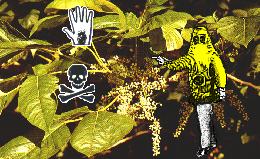 |
POISON
IVY
Unless you're planning on wearing a full-body Kevlar® leotard every
time you walk out of your house, there is a substantial liklihood that you
will encounter some sort of plant or animal nastiness sometime during the
summer. There are bugs, snakes and plants with personal vendetas against
you. Face it, It's a jungle out there. |
|
 The biggest plant pest that you are likely to encounter is the ubiquitous Poison
Ivy, Rhus radicans and it's close relative, Poison Oak. It grows just
about everywhere and so far, it looks like this summer is going to produce an
especially excellent crop. P.I. is extremely variable in its forms, growing
as a vine, a ground cover, or upright. Old vines get very hairy looking. The
old addage is "Leaves of three, leave it be", and refers to the 3
glossy or dull green leaflets, 2 to 4 inches long. The leaves are somewhat variable
in shape. Poison Oak has more irregular leaves. It produces whitish flowers
from August to November that dry and remain for a long time. In the fall, the
leaves take on bright colors --yellow and then turning red. An oil that the
plant produces is responsible for varying degrees of irritation from skin inflammation
to blistering. You don't even have to touch it. You can get it from smoke if
it is being burned. It is said that even 100 year old leaves can cause irritation.
The biggest plant pest that you are likely to encounter is the ubiquitous Poison
Ivy, Rhus radicans and it's close relative, Poison Oak. It grows just
about everywhere and so far, it looks like this summer is going to produce an
especially excellent crop. P.I. is extremely variable in its forms, growing
as a vine, a ground cover, or upright. Old vines get very hairy looking. The
old addage is "Leaves of three, leave it be", and refers to the 3
glossy or dull green leaflets, 2 to 4 inches long. The leaves are somewhat variable
in shape. Poison Oak has more irregular leaves. It produces whitish flowers
from August to November that dry and remain for a long time. In the fall, the
leaves take on bright colors --yellow and then turning red. An oil that the
plant produces is responsible for varying degrees of irritation from skin inflammation
to blistering. You don't even have to touch it. You can get it from smoke if
it is being burned. It is said that even 100 year old leaves can cause irritation.
Peoples' bodies respond
differently to exposure to Poison Ivy. You may get into it once and not experience
any effects, only to be lulled by that false sense of security, get into it
later and become such a blistered and scarred, itchy, freak that you won't want
to leave the house. Sometimes people who have been seemingly immune to the exposure
will have a bout that will make up for all of the times when they were in it
before and didn't get it.
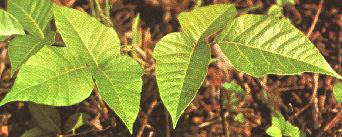
Poison Ivy
Absolutely the best precaution
and defense is recognizing it and avoiding it. Many times though, the recognition
occurs just about the time that you're in it. There are about a gazillion things
that people will tell you to do for Poison Ivy. I've lived vicariously through
my wife, Danielle's, episodes with it and had it myself as well. Danielle develops
strong allergic reactions to it and has been through the whole gamut of remedies
from Calamine to Cortizone injections. I'll repeat this, probably several times,
the best precaution and defense is recognizing it and avoiding it.

Poison Ivy
OK, I'll get to the point
here. After you recognize that you've been in it, the first reaction seems to
be to touch it or scratch it. WRONG. Leave it alone. Don't touch the exposed
area at all, no matter how badly it drives you crazy, until you can wash it.
Many times in the summer when you're outside in the vicinity of Poison Ivy,
you will have developed a sheen of sweat on your body. The oil can be transferred
to other parts of your body if you rub it and then rub another part. It depends
somewhat on your individual tolerance, but some folks have reported that they
got it from their pets who had been in it. Also, when you are warm and sweaty,
your pores are open and contact will help the oil work its way into your skin.
Wash your hands first, then wash the area that has been exposed, then wash your
hands again, then go home and take a shower. Plain water works well. Cold water
seems to work a little better, because it closes your pores fast. Soapy water
or alcohol also work.
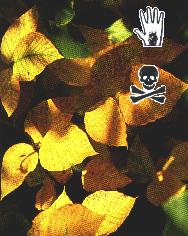
Last summer I was bush-whacking
through the woods, on a friends property while wearing short pants and no socks.
We hadn't gone very far when I noticed that our chosen route was through a big
patch of Poison Ivy. I tried to step carefully, but it was inevitable that I
brushed up against it. Later, we got to a trail that was overgrown with Stinging
Nettles on either side. At that point I was in a high degree of discomfort and
really just wanted to scratch and rub my legs. Though it took a severe bit of
self-discipline, teeth-gritting and transcendental meditation, I didn't touch
my legs at all. As soon as I could, I washed the area with cold water and I
never got a rash at all.
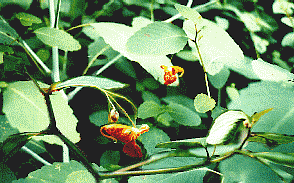 In the southern Appalachians and in much of the eastern U.S., there is a plant
remedy that works very well. Jewel Weed comes in two varieties, with a yellow
flower (Impatiens pallida) or with an orange flower (Impatiens capensis).
The great thing about Jewel Weed is that it often grows right next to Poison
Ivy and is fairly common along roadsides. This plant is a well-known folk remedy
for P.I. and has no reported side-effects. The juice of the Jewel Weed can be
extracted from the stems or leaves, preferably before flowering, but it seems
to work at any time. If you are out in the woods and realize that you have exposed
yourself to Poison Ivy, and are able to find Jewel Weed, you are in luck. Crush
the stems of Jewel Weed to extract the juice and apply it to the area affected
by The P.I. or, apply a poultice of the crushed leaves to the area. The juice
is somewhat sticky and will stay where you put it pretty well. Some folks have
said that tea made from Jewel Weed works as a preventative. To keep a reserve
supply on hand, the best idea seems to be to save the juice as ice cubes to
rub on the infected area. Shred leaves and roots and place in boiling water
for 15 minutes to half an hour, then freeze the liquid in ice cube trays. Jewel
Weed relieves the itching, stops the spread and helps to heal the Poison Ivy
rash. We have found Jewel Weed to be the best remedy of all, even better than
prescription products.
In the southern Appalachians and in much of the eastern U.S., there is a plant
remedy that works very well. Jewel Weed comes in two varieties, with a yellow
flower (Impatiens pallida) or with an orange flower (Impatiens capensis).
The great thing about Jewel Weed is that it often grows right next to Poison
Ivy and is fairly common along roadsides. This plant is a well-known folk remedy
for P.I. and has no reported side-effects. The juice of the Jewel Weed can be
extracted from the stems or leaves, preferably before flowering, but it seems
to work at any time. If you are out in the woods and realize that you have exposed
yourself to Poison Ivy, and are able to find Jewel Weed, you are in luck. Crush
the stems of Jewel Weed to extract the juice and apply it to the area affected
by The P.I. or, apply a poultice of the crushed leaves to the area. The juice
is somewhat sticky and will stay where you put it pretty well. Some folks have
said that tea made from Jewel Weed works as a preventative. To keep a reserve
supply on hand, the best idea seems to be to save the juice as ice cubes to
rub on the infected area. Shred leaves and roots and place in boiling water
for 15 minutes to half an hour, then freeze the liquid in ice cube trays. Jewel
Weed relieves the itching, stops the spread and helps to heal the Poison Ivy
rash. We have found Jewel Weed to be the best remedy of all, even better than
prescription products.
Homeopaths use micro-doses
of Poison Ivy to combat the infection, fighting fire with fire. A series of
preventative injections can be prescribed by a doctor for P.I., but not many
people seem to think they're going to get it before they do. Calamine Lotion,
Caladryl and Benadryl can be applied topically. Many of the topical agents say
not to cover the area after the lotion is applied, but loose bandages that are
changed often have worked for me. After you have the rash, the hardest part
is not scratching it. Bandages keep you from digging at it. Baking Soda compresses
(mix Baking Soda w/ a little water to make a paste) seem to help dry up the
blisters and relieve the itching also. Only trouble is that it flakes off as
it dries. Some of the prescribed cures that my wife has tried have actually
seemed to make the rash worse. Steroids and Cortizone created unpleasant side
effects like sleeplessness and irritability. Did I mention that the best defense
is recogniton and avoidance?

Poison Ivy
STINGING NETTLES
Yet another unpleasant plant that you may enounter out on the trail is Stinging
Nettle (Urtica dioica). The long range effects of Nettles aren't nearly
as pronounced as Poison Ivy, but it can cause pretty intense short-term annoyance.
Nettles have little prickly hairs that stick in your skin and sting and itch
like crazy. Again, don't touch the exposed area. You won't have any trouble
recognizing when you have just walked through Nettles. As soon as you can find
water, wash the exposed area and the discomfort should vanish almost immediately.
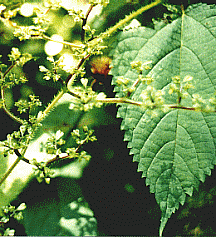
Aside from the stinging
factor, the Nettle is a very useful plant with uses as food and many medicinal
applications. Its constituents include Formic acid, histamines, acetylcholine,
glocoquinones, minerals including iron, silica, potassium, manganese and sulphur
and vitamins A & C.
Nettles can grow just
about anywhere. The fresh green leaves may be cooked and eaten like spinach,
or made into soup or tea. (The sting is not present in the cooked or dried plant
form.) In spring, a tea made from the leaves is a powerful tonic that provides
many important vitamins and minerals. The vitamin C content works to help the
iron be absorbed by the body. There are many folk and homeopathic medicinal
uses for nettles.
So far, I haven't found
any beneficial uses for Poison Ivy. I hope it won't keep you from going outside
though. Good Luck.
©
1995-2002 NCNatural, Last updated


 The biggest plant pest that you are likely to encounter is the ubiquitous Poison
Ivy, Rhus radicans and it's close relative, Poison Oak. It grows just
about everywhere and so far, it looks like this summer is going to produce an
especially excellent crop. P.I. is extremely variable in its forms, growing
as a vine, a ground cover, or upright. Old vines get very hairy looking. The
old addage is "Leaves of three, leave it be", and refers to the 3
glossy or dull green leaflets, 2 to 4 inches long. The leaves are somewhat variable
in shape. Poison Oak has more irregular leaves. It produces whitish flowers
from August to November that dry and remain for a long time. In the fall, the
leaves take on bright colors --yellow and then turning red. An oil that the
plant produces is responsible for varying degrees of irritation from skin inflammation
to blistering. You don't even have to touch it. You can get it from smoke if
it is being burned. It is said that even 100 year old leaves can cause irritation.
The biggest plant pest that you are likely to encounter is the ubiquitous Poison
Ivy, Rhus radicans and it's close relative, Poison Oak. It grows just
about everywhere and so far, it looks like this summer is going to produce an
especially excellent crop. P.I. is extremely variable in its forms, growing
as a vine, a ground cover, or upright. Old vines get very hairy looking. The
old addage is "Leaves of three, leave it be", and refers to the 3
glossy or dull green leaflets, 2 to 4 inches long. The leaves are somewhat variable
in shape. Poison Oak has more irregular leaves. It produces whitish flowers
from August to November that dry and remain for a long time. In the fall, the
leaves take on bright colors --yellow and then turning red. An oil that the
plant produces is responsible for varying degrees of irritation from skin inflammation
to blistering. You don't even have to touch it. You can get it from smoke if
it is being burned. It is said that even 100 year old leaves can cause irritation.

 In the southern Appalachians and in much of the eastern U.S., there is a plant
remedy that works very well. Jewel Weed comes in two varieties, with a yellow
flower (Impatiens pallida) or with an orange flower (Impatiens capensis).
The great thing about Jewel Weed is that it often grows right next to Poison
Ivy and is fairly common along roadsides. This plant is a well-known folk remedy
for P.I. and has no reported side-effects. The juice of the Jewel Weed can be
extracted from the stems or leaves, preferably before flowering, but it seems
to work at any time. If you are out in the woods and realize that you have exposed
yourself to Poison Ivy, and are able to find Jewel Weed, you are in luck. Crush
the stems of Jewel Weed to extract the juice and apply it to the area affected
by The P.I. or, apply a poultice of the crushed leaves to the area. The juice
is somewhat sticky and will stay where you put it pretty well. Some folks have
said that tea made from Jewel Weed works as a preventative. To keep a reserve
supply on hand, the best idea seems to be to save the juice as ice cubes to
rub on the infected area. Shred leaves and roots and place in boiling water
for 15 minutes to half an hour, then freeze the liquid in ice cube trays. Jewel
Weed relieves the itching, stops the spread and helps to heal the Poison Ivy
rash. We have found Jewel Weed to be the best remedy of all, even better than
prescription products.
In the southern Appalachians and in much of the eastern U.S., there is a plant
remedy that works very well. Jewel Weed comes in two varieties, with a yellow
flower (Impatiens pallida) or with an orange flower (Impatiens capensis).
The great thing about Jewel Weed is that it often grows right next to Poison
Ivy and is fairly common along roadsides. This plant is a well-known folk remedy
for P.I. and has no reported side-effects. The juice of the Jewel Weed can be
extracted from the stems or leaves, preferably before flowering, but it seems
to work at any time. If you are out in the woods and realize that you have exposed
yourself to Poison Ivy, and are able to find Jewel Weed, you are in luck. Crush
the stems of Jewel Weed to extract the juice and apply it to the area affected
by The P.I. or, apply a poultice of the crushed leaves to the area. The juice
is somewhat sticky and will stay where you put it pretty well. Some folks have
said that tea made from Jewel Weed works as a preventative. To keep a reserve
supply on hand, the best idea seems to be to save the juice as ice cubes to
rub on the infected area. Shred leaves and roots and place in boiling water
for 15 minutes to half an hour, then freeze the liquid in ice cube trays. Jewel
Weed relieves the itching, stops the spread and helps to heal the Poison Ivy
rash. We have found Jewel Weed to be the best remedy of all, even better than
prescription products.